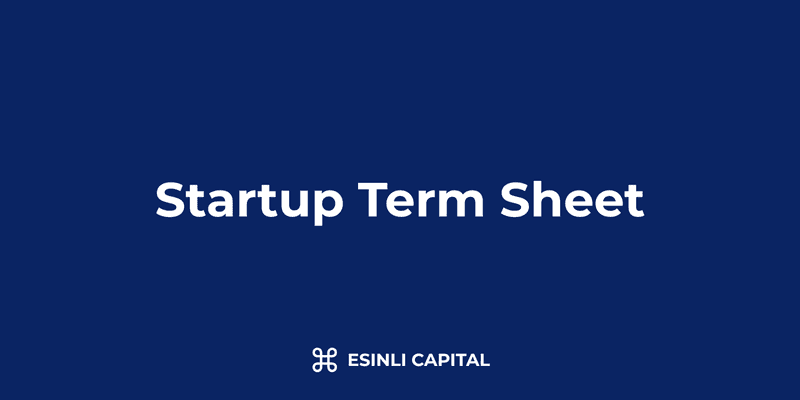In This Article

Startup Term Sheet: Definition, Components & Templates
KEY TAKEAWAYS
- A term sheet is a non-binding document that outlines the key terms and conditions of a potential investment in a startup, serving as a blueprint for the final legal agreements
- The most critical term sheet components include valuation, investment amount, equity allocation, investor rights, liquidation preferences, and governance provisions
- Term sheets vary significantly based on funding stage, with seed-stage term sheets being simpler than later-stage ones which include more investor protections
- Founders should focus on negotiating valuation, liquidation preferences, anti-dilution provisions, and board composition to maintain control and protect future fundraising flexibility
- While term sheets are generally non-binding, certain provisions like confidentiality, exclusivity, and expense allocation are often legally enforceable
What Is a Startup Term Sheet?
A startup term sheet is a document that outlines the preliminary terms and conditions of an investment in a startup company. It serves as a blueprint for the more detailed legal documents that will follow if both parties agree to move forward with the investment. Term sheets are typically issued by investors (usually venture capital firms or angel investors) to startups seeking funding.
Think of a term sheet as a letter of intent or a memorandum of understanding—it's not legally binding in its entirety, but it establishes the framework for the investment relationship. The document is crucial because it addresses the most important aspects of the deal: how much money is being invested, at what valuation, what rights the investors will have, and what protections will be put in place for both founders and investors.
Purpose and Importance of Term Sheets
Term sheets serve several critical purposes in the startup investment process:
-
Creating clarity: By outlining key terms upfront, the document reduces misunderstandings between founders and investors about expectations and deal structure.
-
Saving time and money: Having a preliminary agreement in place before drafting extensive legal documents saves legal costs and prevents wasted effort on deals that won't close.
-
Establishing a framework for negotiation: The term sheet provides a structured starting point for negotiations between founders and investors.
-
Setting precedent for future rounds: Terms agreed to in early funding rounds often carry forward to later rounds, making initial term sheet negotiations particularly important.
-
Due diligence trigger: Once a term sheet is signed, the formal due diligence process typically begins, during which investors thoroughly examine the company's operations, finances, and legal status.
Morgan Livermore, partner at Andreessen Horowitz, emphasizes that "a good term sheet isn't just about getting the best possible terms for one side—it's about creating alignment between founders and investors for the long journey ahead."
Term Sheet Components and Structure
A comprehensive startup term sheet typically includes several key sections, each addressing different aspects of the investment relationship. While terms can vary widely depending on the investor, stage of funding, and company specifics, most term sheets include these fundamental components:
Economic Terms
The economic terms section covers the financial aspects of the deal, including:
Valuation: Perhaps the most scrutinized term, this establishes the pre-money value of the company (before the investment) and consequently, how much equity the investors will receive for their capital.
Investment Amount: The total capital being invested, sometimes broken down by participating investors if there are multiple parties.
Type of Security: Specifies whether the investment is in preferred stock, convertible notes, SAFE (Simple Agreement for Future Equity), or another instrument.
Funding Tranches: Larger investments are sometimes structured in "tranches," or portions, released when the company achieves specific milestones.
Option Pool: Details regarding the employee stock option pool, including how much it will be expanded (typically 10-20% of the post-money valuation) and whether this comes from existing shareholders or new money.
Control and Governance Terms
This section addresses how decisions will be made and who gets a say in company management:
Board Composition: Outlines the structure of the board of directors, including how many seats go to founders, investors, and independent directors.
Voting Rights: Specifies which decisions require approval from specific investors or share classes, particularly for major company decisions.
Protective Provisions: Lists actions that require approval from preferred shareholders, such as selling the company, issuing new shares, or taking on significant debt.
Information Rights: Details what company information (financial statements, budgets, etc.) investors are entitled to receive and how frequently.
Investor Rights and Protections
These terms protect investors' interests:
Liquidation Preference: Determines how proceeds are distributed in a liquidity event (like an acquisition), often giving investors the right to receive their investment back before common shareholders (founders and employees) receive anything.
Anti-dilution Provisions: Protects investors from significant dilution if future funding rounds occur at lower valuations (commonly referred to as "down rounds").
Pro Rata Rights: Gives investors the right to maintain their ownership percentage by participating in future funding rounds.
Redemption Rights: Allows investors to force the company to buy back their shares under specific circumstances.
Registration Rights: Provides investors with rights related to registering their shares for public sale after an IPO.
Exit and Liquidity Terms
These terms address what happens when the company is sold or goes public:
Drag-Along Rights: Allows majority shareholders to force minority shareholders to join in selling the company if a legitimate offer is received.
Tag-Along Rights: Gives minority shareholders the right to join in a sale transaction initiated by majority shareholders.
Right of First Refusal (ROFR): Gives the company and/or existing investors the right to purchase shares being sold by other shareholders before they can be sold to outside parties.
Co-Sale Rights: Similar to tag-along rights, these allow investors to sell a proportional amount of their shares alongside founders if founders decide to sell.
Legal and Administrative Terms
The final section typically addresses:
Exclusivity: Prevents the startup from shopping the deal to other investors for a defined period (usually 30-60 days).
Confidentiality: Requires all parties to keep the terms of the deal private.
Expenses: Outlines who pays for legal and due diligence expenses (often the company, with a cap).
Binding Terms: Clarifies which specific provisions are legally binding even if the overall term sheet is not (typically confidentiality, exclusivity, and expenses).
Term Sheets by Funding Stage
Term sheets vary considerably depending on the funding stage of the startup. Understanding these differences is crucial for founders approaching different types of investors.
Pre-Seed and Seed Stage Term Sheets
At the earliest stages, term sheets tend to be simpler and founder-friendly, reflecting the high risk but also the relatively small investment amounts.
Typical terms include:
- Use of convertible instruments like SAFEs or convertible notes rather than priced equity rounds
- Fewer investor protections and control provisions
- Simpler liquidation preferences (usually 1x, non-participating)
- Minimal or no board seats for investors
- Shorter documents (sometimes just 3-5 pages)
Y Combinator's SAFE documents have become standard in many seed-stage deals because of their simplicity and founder-friendly terms. These agreements defer valuation discussions to the next funding round while still allowing investors to provide capital.
Series A Term Sheets
When startups raise their first significant priced equity round (typically $2-15 million), term sheets become more comprehensive.
Common Series A terms include:
- Detailed valuation and equity allocation
- 1x liquidation preference, sometimes with participation
- Creation of a formal board structure (often 5 members: 2 founders, 2 investors, 1 independent)
- Standard investor protections including anti-dilution provisions
- Pro rata rights for future rounds
- Document length increases to 8-12 pages
Series B and Beyond
As companies mature and raise larger rounds, term sheets become increasingly investor-protective and complex.
Late-stage term sheets often feature:
- Multiple liquidation preferences (1.5x-2x)
- Senior preferences over earlier investors
- More stringent protective provisions
- Detailed ratchet-based anti-dilution protections
- Redemption rights after a certain timeframe
- Extensive information rights
- More investor-favorable vesting terms for founders
- Documents expanding to 15+ pages
How to Read and Negotiate a Term Sheet
For founders, understanding how to interpret and negotiate term sheets is crucial to securing favorable terms that won't hamstring the company's future.
Key Terms Founders Should Focus On
Not all term sheet provisions carry equal weight. Founders should prioritize negotiating these high-impact terms:
-
Valuation: Directly affects dilution and how much of the company founders retain.
-
Liquidation Preferences: Can dramatically impact founder payouts in an exit, especially if they include participation rights or multiples greater than 1x.
-
Board Composition: Determines who controls major decisions and whether founders maintain control of their company.
-
Protective Provisions: Can give investors veto power over important business decisions.
-
Anti-dilution Provisions: Poorly negotiated terms can severely dilute founders in down rounds.
-
Founder Vesting: Ensures founders remain committed while protecting them from unfair dismissal.
Common Negotiation Tactics
Experienced founders and investors recommend these strategies when negotiating term sheets:
-
Negotiate multiple term sheets simultaneously: Having alternatives increases leverage.
-
Understand market standards: Resources like the NVCA model documents provide benchmarks for what's standard.
-
Focus on the big issues: Don't expend negotiating capital on minor terms that won't significantly impact outcomes.
-
Consider the full picture: Sometimes accepting a lower valuation can result in better terms overall.
-
Remember future rounds: Terms that seem acceptable now might create problems for future fundraising.
-
Seek expert advice: Experienced startup attorneys can spot problematic terms that founders might miss.
Brad Feld, managing director at Foundry Group and author of "Venture Deals," advises: "Founders should remember that they're not just negotiating terms for this round, but setting precedents that will impact every future round of financing."
Red Flags in Term Sheets
Founders should be wary of these potentially troublesome provisions:
- Multiple liquidation preferences (>1x) with participation rights
- Full-ratchet anti-dilution instead of weighted average
- Investor-heavy board control from the outset
- Excessive option pool increases applied pre-money
- Redemption rights that kick in too early
- Overly broad protective provisions that hamper operational flexibility
- Founder vesting without adequate acceleration provisions
Term Sheet Templates and Examples
Understanding abstract concepts is easier with concrete examples. Here are resources for standard term sheet templates and samples by stage:
Standard Term Sheet Templates
Several organizations provide standardized term sheet templates that represent industry norms:
-
National Venture Capital Association (NVCA) offers comprehensive model legal documents including term sheets that are widely used in the industry.
-
Y Combinator's SAFE documents provide standardized early-stage investment agreements.
-
Series Seed Documents created by Fenwick & West offer streamlined documents for seed rounds.
-
500 Startups' KISS (Keep It Simple Security) documents provide alternatives to the SAFE.
Seed-Stage Term Sheet Example
A typical seed-stage term sheet using a SAFE might include:
- Investment amount: $500,000
- Valuation cap: $5 million
- Discount rate: 20% (from the next round's price)
- Pro rata rights: Yes
- Most Favored Nation (MFN) provision: Yes
- No board seats or controlling provisions
Series A Term Sheet Example
A typical Series A term sheet might feature:
- Pre-money valuation: $10 million
- Investment amount: $3 million
- New option pool: 15% (post-money)
- Board structure: 5 directors (2 founders, 2 investors, 1 independent)
- Liquidation preference: 1x, non-participating
- Protective provisions: Standard (major corporate changes)
- Anti-dilution: Weighted average
- Pro rata rights: Yes for new investors
Startup Term Sheet vs. Final Documents
While term sheets lay the groundwork, they're followed by more detailed legal documents that formalize the investment. Understanding the relationship between the term sheet and final documents is important.
Legal Status of Term Sheets
Most term sheets are explicitly non-binding, with a few exceptions:
-
Non-binding provisions: The majority of a term sheet's provisions (economic terms, investor rights, etc.) are not legally enforceable until incorporated into final documents.
-
Binding provisions: Certain sections are typically binding even if the deal doesn't close:
- Confidentiality clauses
- Exclusivity periods ("no-shop" provisions)
- Expense allocations
- Sometimes break-up fees
From Term Sheet to Definitive Agreements
Once a term sheet is signed, several steps follow:
-
Due diligence: Investors thoroughly review the company's financials, legal status, contracts, IP, and operations.
-
Drafting of definitive agreements: Attorneys prepare formal legal documents, typically including:
- Stock Purchase Agreement
- Investor Rights Agreement
- Voting Agreement
- Right of First Refusal and Co-Sale Agreement
- Amended and Restated Certificate of Incorporation
-
Negotiation of final details: Many smaller points not covered in the term sheet are addressed during this phase.
-
Signing and closing: Once all parties agree to the final documents, the investment is completed, and funds are transferred.
The time from term sheet to closing typically ranges from 30 to 90 days, depending on the complexity of the deal and any issues discovered during due diligence.
Common Term Sheet Mistakes and How to Avoid Them
Both founders and investors can make mistakes during the term sheet process. Here's how to avoid the most common ones:
For Founders
-
Not understanding the terms: Never sign a term sheet containing provisions you don't fully understand.
-
Fixating only on valuation: A high valuation with unfavorable terms can be worse than a lower valuation with clean terms.
-
Neglecting future implications: Terms that seem acceptable for the current round may create problems for future fundraising.
-
Rushing the process: While momentum is important, thoroughly reviewing terms with advisors is crucial.
-
Accepting non-standard terms: Unusual provisions can make future rounds more difficult to close.
For Investors
-
Overreaching on terms: Excessively investor-favorable terms can damage relationships with founders and reputation in the market.
-
Neglecting alignment of interests: Terms should create win-win scenarios, not win-lose dynamics.
-
Inadequate term sheet clarity: Ambiguous provisions lead to misunderstandings and extended negotiations later.
-
Focusing too much on downside protection: Over-protecting against failure can hamper a company's growth potential.
The Bottom Line
Term sheets are a critical milestone in the startup fundraising process, establishing the foundation for the relationship between founders and investors. While they may seem intimidating at first, a solid understanding of standard provisions and negotiation strategies can help founders secure terms that protect their interests while still attracting the capital they need.
Remember that the best term sheets create alignment between founders and investors toward a common goal: building a successful company. Focusing on creating this alignment, rather than "winning" every point in the negotiation, typically leads to better outcomes for all parties.
For founders, investing time in understanding term sheets before beginning fundraising, seeking advice from experienced advisors, and maintaining negotiating leverage through multiple options are the keys to achieving favorable terms that will support the company's growth for years to come.
Startup Term Sheet FAQ
What makes a term sheet binding vs. non-binding?
Term sheets are generally non-binding documents, meaning they don't legally obligate either party to complete the transaction. However, specific provisions—typically confidentiality, exclusivity, and expense allocation—are often explicitly made binding within the term sheet. The document usually states clearly which provisions are binding and which are not.
How long should term sheet negotiations take?
Term sheet negotiations typically take between one and three weeks, though this can vary based on complexity and the number of parties involved. Extending beyond this timeframe often indicates fundamental disagreements or can cause deal momentum to fade.
What is the difference between pre-money and post-money valuation in a term sheet?
Pre-money valuation is the company's value before the new investment, while post-money valuation is simply the pre-money valuation plus the new investment amount. This distinction is crucial as equity percentages are calculated from these figures. For example, a $2 million investment at a $8 million pre-money valuation gives investors 20% ownership ($2M ÷ $10M post-money).
What are typical liquidation preferences in different funding stages?
- Seed stage: Usually 1x non-participating
- Series A: Typically 1x, sometimes with participation
- Series B and later: Often 1x-1.5x, with participation more common
- Down rounds or troubled companies: May see 1.5x-2x with full participation
How do convertible notes and SAFEs appear in term sheets?
Convertible notes and SAFEs are often used in place of traditional term sheets for early-stage investments. These documents are simpler and typically specify:
- Investment amount
- Valuation cap
- Discount rate
- Interest rate (for notes only)
- Maturity date (for notes only)
- Conversion triggers
Can a signed term sheet be revoked?
Since term sheets are generally non-binding, either party can legally walk away before definitive agreements are signed. However, doing so can damage reputations and relationships. The binding exclusivity provision prevents founders from shopping the deal to other investors during the specified period, typically 30-60 days.
How do term sheets differ internationally?
While the fundamental concepts remain similar, term sheets do vary across different startup ecosystems:
- US term sheets tend to be more investor-favorable with more complex protections
- European term sheets often have fewer investor protections and simpler structures
- Asian term sheets frequently include strategic elements beyond just financial investment
These differences are gradually harmonizing as the global venture capital market becomes more interconnected.



